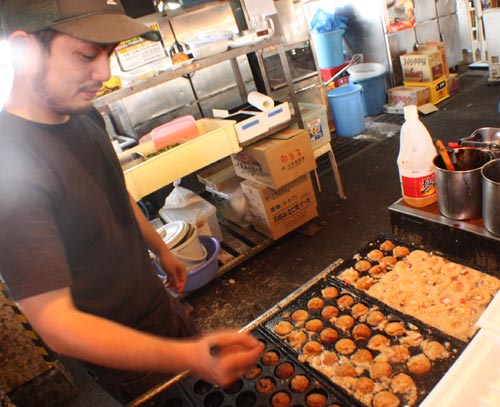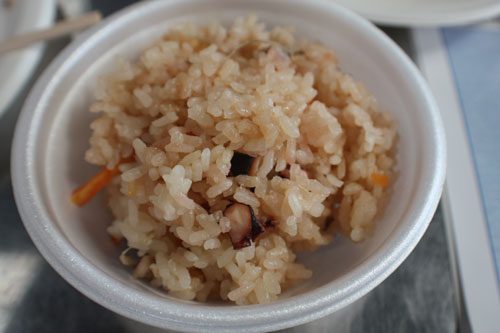Fish hang to dry from clothespins and octopi are cleaned in washing machines at the Tore-Tore Fish Market, near Osaka in Japan. Not far from the Old Sakai Lighthouse, the market opens at ten in the morning, welcoming diners to a unique al fresco dining experience. The fifteen year-old market is quite popular with locals as well as tourists, for its fresh seafood, which is cooked on the spot. "It's all fresh from the sea. Compared to other markets, the prices are relatively very low," says a man as holds out an octopus for us to touch. Literally "fresh-fresh," tore-tore offers a variety of sea food including octopi, which can be found all over at stands selling takoyaki - a popular savory snack made with a chewy slice of octopus tucked in a blanket of chopped vegetables, and cooked in soft batter that melts in your mouth. It looks, smells, and tastes delicious, but that's if you don't really think about it too much.
Click here to view full screen At the market, diners see their seafood before it is cooked - an experience which is somewhat disturbing, even for the coldest carnivores. The live octopus is rubbed down with salt, then tossed in a washing machine. The tub is filled with water, the dial turned, and the octopus is spun around for a few minutes until it's slime-free, from its head to the tips of its eight tentacles. At the very least, watching the process can make you squirm, but for some, it's just another efficient method to clean food. It could set the stage for a long discussion on why we eat animals in the first place, but at the Tore-Tore fish market, people come to eat, not talk.

One of the most popular snacks at the market is takoyaki - balls made with octopus tucked into a blanket of chopped vegetables, and cooked in soft batter that melts in your mouth.
What's available depends on the season. The migratory fish called Anago, which like to swim in cold water, are only available in autumn. In the spring, there's plenty of Ika, Japanese for squid. In the summer, it's octopus, and Tako meshi (octopus mixed with rice) is a bestseller. Traveling without tasting the local food is like going to an amusement park without getting on any of the rides. Sure, you might be able to enjoy the sights, sounds and smells - but even the baby who only rides the carousel knows you're missing out. Getting dizzy and throwing up are definite possibilities, but it's worth it. In this case, there's no getting dizzy, nor throwing up. The market is so clean that the smell of fish is faint, and to some extent, even pleasant. The vendors smile from their stalls, where the fresh food is on display. The air sizzles with delicious smells as the oil bubbles in pans and colorful vegetables roast over small grills. Apart from fresh seafood, you can also buy vegetables, beer or tea, and bottled soy sauce, wasabi, and other condiments. There are rows of tables with mismatched chairs and diners sit apart, cooking their own food. Salt and different kinds of sauce are found at every table, and each diner seasons his own food. As the food slowly disappears from the table, not a sound can be heard. Everyone is too busy picking squid, fish, clams, crab, and octopus from their plates.

The catch of the day is best enjoyed with a bowl of tako meshi, or octopus rice.
In a place where much of the food is unfamiliar - bento boxes with tofu and beancurd of all shapes and sizes, all shades of seaweed, an assortment of fish paste and pickled vegetables - the Tore-Tore market is a refreshing experience. Since you see the food before it's cooked, it's easy to identify what it is exactly that you're about to chew. It's a bit difficult to keep from just setting your chopsticks down and eating with your hands, but it isn't that laid-back. Still, the outdoor setting is relaxing, and there's less pressure to be prim and proper. It's just as well because everything is tender and succulent, and who wants to worry about bits of food on your chin when the meal is this good? From the dining area, you can see Osaka Bay, and as the midday sunlight bounces off the water, you wish that siesta were a Japanese custom - but of course, it isn't, and you have to get back to work. Meanwhile, the Tore-Tore market remains open until five in the afternoon, for late lunch or very early dinner. Whatever time you visit, you can be sure the food is so fresh it deserves to be said twice. -
YA, GMA News Photos by Candice Montenegro, GMA News 






